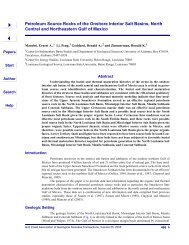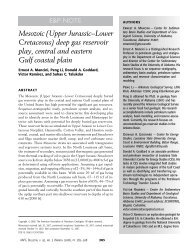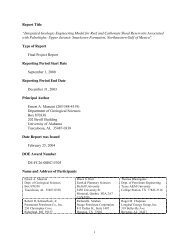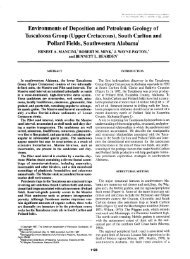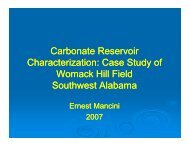Part 4 - Berg - Hughes Center
Part 4 - Berg - Hughes Center
Part 4 - Berg - Hughes Center
Create successful ePaper yourself
Turn your PDF publications into a flip-book with our unique Google optimized e-Paper software.
Haynesville-Buckner Formation<br />
Producing Parishes<br />
Bossier, Claiborne<br />
Forgotson and Forgotson (1976) described the Haynesville in southern Arkansas and<br />
northern Louisiana, as red shales and pink to white sandstones that grade laterally into the<br />
Gilmer Limestone in East Texas and basinward into black shale lithologically similar to<br />
the Bossier Shale. In some areas, the Haynesville or Gilmer Limestone (commonly called<br />
Cotton Valley Lime) rests unconformably on the Smackover Formation. The Buckner<br />
Member of the Haynesville (primarily red shale, sandstone, anhydrite, and limestone<br />
lenses) is transitional with the underlying Smackover limestone. According to Salvador<br />
(1987), the lower Buckner (Kimmeridgian) section reflects depositional environments<br />
that are less marine or shallower water marine than those of the underlying Oxfordian<br />
Smackover, because the Buckner consists of evaporitic deposits and associated red beds<br />
formed in hypersaline coastal lagoons or sabkhas. At North Haynesville field, most of the<br />
thick Buckner consists largely of red and greenish-gray mudstone and shale with varying<br />
amounts of nodular anhydrite and with a few thin beds of white to red, anhydritic<br />
sandstone (Bishop, 1971).<br />
In Texas, Louisiana, and Arkansas, Dickinson (1968a, 1968b, 1969) divided the<br />
Buckner into two members, each of which is gradational with the Smackover in different<br />
areas. The lower is predominantly anhydrite and anhydritic mudstone, and was deposited<br />
in an evaporite basin north of a chain of salt-cored anticlines. The upper member consists<br />
largely of red and greenish-gray mudstone and shale with nodular anhydrite. Several<br />
zones of calcarenites similar to those of the Smackover are present in a general east-west<br />
trend area, and at least one of them, the "A" zone, extends regionally across most of<br />
354




